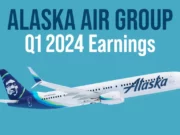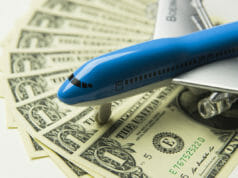 Generally, the concept of airline pay is fairly complex. As we discussed in the Contract Talk about monthly guarantee, the basic pay is determined with a starting bank and then work is credited toward that bank until the credit matches or exceeds the bank, in which case the pilot gets paid the credit amount. One of the common forms of compensation that separates one airline contract from another is called “soft pay.” Soft pay refers to a category of compensation where a pilot may be compensated even though there was no actual block time flown, or duty worked. This will be in addition to the normal block pay and can come in many different forms. Soft pay can have a tremendous effect on actual compensation from one airline to another, even if the basic block pay rate is the same between the companies.
Generally, the concept of airline pay is fairly complex. As we discussed in the Contract Talk about monthly guarantee, the basic pay is determined with a starting bank and then work is credited toward that bank until the credit matches or exceeds the bank, in which case the pilot gets paid the credit amount. One of the common forms of compensation that separates one airline contract from another is called “soft pay.” Soft pay refers to a category of compensation where a pilot may be compensated even though there was no actual block time flown, or duty worked. This will be in addition to the normal block pay and can come in many different forms. Soft pay can have a tremendous effect on actual compensation from one airline to another, even if the basic block pay rate is the same between the companies.
One such form of pay that is contingent on an airline’s specific contract and more specific circumstances is called “add pay.” Add pay is essentially nothing more than money that is paid in addition to monthly guarantee, even if the pilot didn’t break guarantee that month.
As an example, say Airline A pays add pay on any days off that are “rolled” or lost to another day of duty for some reason beyond the pilot’s control, such as weather. If Airline A’s contract allows for additional compensation to be paid for the day off lost, and that pay occurs on top of guarantee, this would be add pay.
Using Airline A, as in the example above, we’ll assume that the contract at this carrier allows for 3.75 hours credit at 150% of hourly pay or actual credit on that day (whichever is greater), for each day off lost to the pilot. We will also assume that the money is add pay as specified in Airline A’s contract. What this essentially says is that even if the above pilot is reserve and only flies 15 hours that month (including 2 hours on the day in question), they will still receive 3.75 hours at 150% of their normal pay on top of their minimum monthly guarantee. Effectively, even though this pilot only flew for a total of 15 hours that month, (including the time on the lost day off) they will be paid 80.7 hours equivalent at their normal pay, rather than the standard 75 hours of guaranteed block pay.
It is contingent upon each contract, but often add pay will be offered for any trips picked up on days off or during vacation, lost days off, or other assignments as specified. As another common example, Airline A may pay a minimum of 150% credit for all trips picked up out of open time, while Airline B may automatically pay 150% on advertised days, and 200% on other advertised days depending on how badly they need trips covered. Airline C may specify in the contract that anything paid over “x” hours of block is paid at 150%.
If a trip is picked up out of open time and contractually paid at 200% rather than 150%, then a 20-hour 4 day trip will be credited at 40 hours of pay in the 200% contract and 30 hours of pay in the 150% example. Not only can this have a significant impact on a pilot’s ability to break guarantee, but it can also significantly affect a pilot’s ability to be compensated beyond the 100 hour FAA flight time limit. When calculated against the hourly pay rate, it can have a profound effect on actual compensation to the tune of thousands of dollars a year, as even 1 or 2 trips picked up per month could potentially increase the amount of actual credit by 50 hours or more.
The benefit to add pay is that if available, it can be used to greatly enhance the quality of a pilot’s compensation. It is especially helpful for low credit reserve pilots who have little chance of breaking guarantee in a month. For instance, if the reserve pilot lost a day off and was compensated with add pay, this can easily affect their monthly gross income by several hundred dollars or more.
Another example of add pay is “block or better” compensation. This essentially means that a pilot will never be paid less than the block that was scheduled. If actual flight time exceeds the blocked amount (for instance in a weather delay), then the pilot will be compensated at the actual amount of flight time. If the flight blocks in with less than scheduled flight time (for example a 10 minute savings due to ATC shortcuts), the pilot will still be paid the scheduled block amount, even though the actual flight time may be shorter.
Compare this to another airline that pays actual or block, and again, the pay over the course of a year can be quite a bit lower, even at the same hourly pay rate. Essentially, this airline is going pay the block amount, even if block is exceeded (the same weather delay example used above). In the second scenario where the flight is a few minutes early, this airline is going to pay the actual flight time, which was less than block. Again, over the course of a year, this can potentially reduce the pay by thousands of dollars a year compared to a pilot at an airline that pays block or better.
While not the only form of compensation to consider at an airline, understanding “soft pay” is one of the most challenging aspects of comparing airline contracts, but is also one of the most important as it has potentially the largest ability to differentiate the pay scales amongst various carriers. The airline grid at the back of the magazine is a good way to start researching the various forms of soft pay and how they affect the compensation at a particular airline, which may vary profoundly from another airline, even though the pay scales are identical or similar.

























































